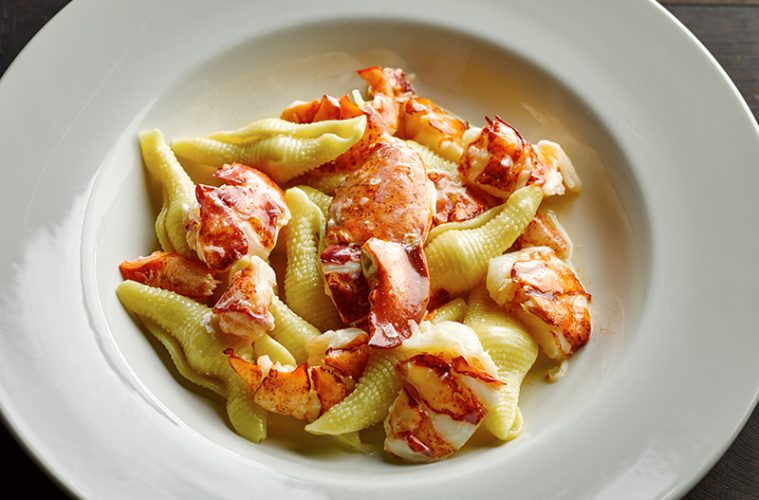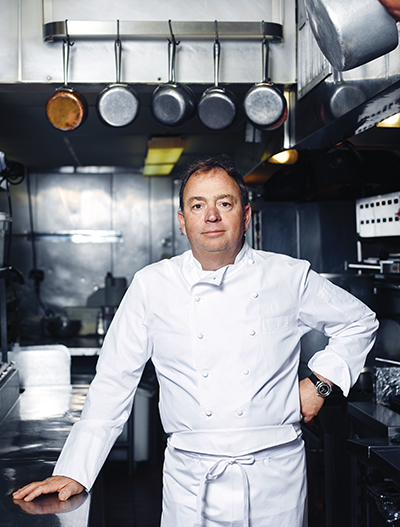Executive chef Marvin Posada breaks into a wide grin when talking about the beehives on the roof of L’Andana in Burlington. “It takes me back to my childhood,” says Posada, a native of El Salvador. “Back home, my mom has a tree trunk that is 30 years old” where wild bees have always made honey. “We have honey year-round.”
L’Andana’s hives, which were a suggestion from the restaurant’s bee-keeping handyman, now produce about 15 gallons of honey a year. The hyper-local sweetener has inspired a number of menu items, including an appetizer of house-made ricotta cheese topped with honey and shaved truffles. The honey is also prominently featured on the restaurant’s new Sunday brunch menu, which launched last fall.
Since opening seven years ago, L’Andana has been augmenting its menu—and beautifying its suburban business-corridor location— with plantings that go well beyond a typical kitchen garden, says chef-owner Jamie Mammano. “We’ve created a tiny farm where the chef is out there harvesting,” says Mammano. “We have apple trees, greens, eggplant, herbs, bees on the roof, fresh tomatoes—it doesn’t get any better than that.”
Posada, responsible for the restaurant’s day-to-day operations since becoming executive chef six years ago, has grown the garden from just a few raised beds to about 25, and he draws a lot of inspiration from the seasonal array. “I just can’t wait to get things in the ground,” Posada says. “I love gardening. It’s one of the things that keeps me very creative in the spring and summer.”
The gardens fit well with L’Andana’s overall aesthetic—the weathered-wood walls and chandeliers made from old wine barrels evoke what Mammano terms “an elegant barn,” making the space incredibly popular for weddings and other special events.
The balancing act between sophisticated and rustic is something L’Andana has perfected—and it comes straight from Mammano, who admits he is a stickler about “everything”—from hot plates to the look of each dish as it comes out of the kitchen. A chef inspects each plate before it is served, ensuring the dishes consistently meet Mam- mano’s exacting standards.
|
Both Mammano and Posada agree that consistency is critical to the restaurant’s continued success. “If a customer comes back and a dish is not the same, that will cause us to fail,” Posada says.
That consistency is the result, in part, of a low staff turnover rate. Many employees have been with L’Andana since it opened, and some, including Posada, worked at other restaurants in Mammano’s well-regarded empire of six eateries. Posada gestures around the kitchen, noting that pastry chef Suzanne Giaquinto has been with the restaurant for seven years, and many others have been there for nearly as long.
In an industry that is dogged by high turnover, Posada says Mammano’s leadership keeps people at L’Andana. “The chef-owner is very inspiring,” Posada says. “Whether a work[-related] or personal question, he always has time for us.” And Mammano’s approach in the kitchen is equally inspiring, Posada says, explaining that when the staff is trying new dishes, Mammano often has a suggestion for taking them to the next level—whether by intensifying flavors, using an ingredient in a new way, or playing with presentation.
“Once in a while, I can’t figure out how to plate a dish,” Posada says. “[Mammano] spends 30 seconds rearranging things and it looks perfect. It’s almost magical.”
Though strict in terms of standards, the kitchen is also flexible enough to accommodate differences between its suburban clientele in Burlington and that of Columbus Restaurant Group’s five Boston eateries. In the city, busy times are spread out over the course of an evening, while “the window in a suburban restaurant is very small. Everyone wants to eat between 7 p.m. and 8 p.m.,” explains Mammano. That makes for a very intense hour for kitchen staff, and the occasional compromise on the menu. Mammano says sometimes a chef will suggest a new menu item, but it is too complex to guarantee perfection when things get busy. “If I question [if] it can be executed under pressure, it won’t go on the menu,” Mammano says.
Just because something isn’t on the menu doesn’t mean a customer can’t have it, however. Posada has been surprised by the number of substitutions requested. “People in the suburbs make more special requests—even things that are not on the menu,” he says, recalling a time when a customer requested a vodka sauce. “I’d never made a vodka sauce before,” he notes. After a quick Google search, Posada put something together with a L’Andana spin on it—and the customer was happy.
Of course, the majority of customers keep coming back because of what is on the menu—not what isn’t. While about a third of the menu changes with the seasons or what’s exciting to the chefs, the other two-thirds features the familiar. “We tried to change the rigatoni Bolognese,” he says, by substituting fresh pasta for dried, but it just wasn’t the same. “It’s the only dish we serve with dried pasta,” he says, explaining that, for Bolognese, the sauce just doesn’t cling to fresh pasta in the same way, and it doesn’t have the right bite.
That attention to detail is at the heart of everything at L’Andana, where they make as much as they can in-house—right down to aging their own beef for a minimum of 40 days—a process that took a lot of work to perfect, according to Posada. “We had to figure out what temperature the cooler needed to be, the humidity level, and what types of beef worked best,” he says, adding that the restaurant uses Omaha Prime beef. Occasionally, if there is a run on steak, it comes off the menu until more can be aged, ensuring that the diner has the same experience every time.
“Everything here is unique,” Posada says of their approach. “The ricotta you eat here—you won’t have it anywhere else.”
 |
One might think that running six top area restaurants would be enough to keep chef Jamie Mammano busy, but his passion for authentic cuisine has driven him to pursue a new “hobby,” he says, and a very successful one at that. Four years ago, he launched Tortilleria La Nina in Everett, making corn tortillas and tortilla chips by hand using non-GMO, U.S.-grown corn and a centuries-old method for crafting the chips.
Mammano’s wife is from Mexico, and after every trip to visit his in-laws, he would haul back suitcases full of handmade tortillas. Finally tired of waiting for shipments from south of the border, he decided to start making them himself, to delicious effect.
“We are making tortillas and corn chips the way they were made 100 years ago,” Mammano says. That entails cooking the whole-grain corn with water and lime (from limestone, not the citrus fruit) and then using hand- carved volcanic stones to grind the corn mixture. The process, called “nixtamalization,” improves the corn’s nutritional value and enhances the flavor.
Though Tortilleria La Nina opened in 2011, Mammano says it’s really just taken off in the past year, especially since Whole Foods started stocking his tortilla chips in all its New England stores. With the Everett bakery now at capacity, Mammano is looking to expand. And his “hobby” is quickly growing into something more. landanagrill.com, laninatortilla.com


 Chef-owner Jamie Mammano
Chef-owner Jamie Mammano